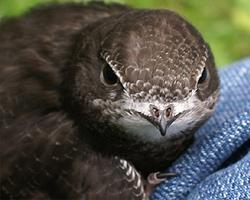
Veszélyeztetettség
| Veszélyeztetett |
Állatleírás
The Alpine swift (Tachymarptis melba) is a remarkable bird, celebrated for its extraordinary flight capabilities and distinctive appearance. This species belongs to the swift family, Apodidae, a group of birds known for their aerial prowess. Alpine swifts are particularly notable for their large size compared to other members of the swift family, with a wingspan that can reach up to 57 centimeters (22 inches) and a body length of about 20-23 centimeters (7.9-9.1 inches).Physically, the Alpine swift presents a sleek and streamlined body, perfectly adapted for life in the air. Its plumage is predominantly a crisp, dark brown or black on the upper parts, with a contrasting white throat and belly. The demarcation between these two colors is sharply defined, adding to the bird's striking appearance. The tail is slightly forked, and the long, narrow wings are designed for efficient high-speed flight. These physical adaptations allow the Alpine swift to undertake remarkable feats of endurance and agility in the air.
One of the most fascinating aspects of the Alpine swift's behavior is its migratory pattern. These birds breed across mountainous regions of southern Europe, North Africa, and across Asia, preferring rocky outcrops and cliffs where they can nest. As the breeding season ends, they embark on long migrations to sub-Saharan Africa, where they spend the winter. During these migrations, Alpine swifts are capable of flying thousands of kilometers, showcasing their incredible stamina and navigation skills.
Alpine swifts are highly aerial birds, spending most of their lives in flight. They feed on a diet of airborne insects, which they catch with their wide, gaping mouths while flying. This diet includes a variety of flying insects, such as flies, ants, and aphids. Remarkably, these birds are known to eat, sleep, and even mate while airborne, touching down only to nest. Recent studies have revealed that Alpine swifts can remain airborne for months at a time, covering vast distances without ever landing.
The nesting habits of the Alpine swift are as intriguing as their flight capabilities. They typically nest in colonies on vertical cliffs, laying their eggs in crevices or on ledges. The nests are constructed from materials like feathers and grass, glued together with the bird's saliva. Both parents share the responsibility of incubating the eggs and feeding the chicks until they are ready to fledge.
Despite their widespread range and adaptability, Alpine swifts face threats from habitat destruction and climate change, which could impact their breeding sites and food availability. However, they currently maintain a status of Least Concern on the IUCN Red List, indicating a stable global population.
In summary, the Alpine swift is a marvel of the avian world, embodying the essence of aerial mastery. Its life high above the ground, from its incredible migratory journeys to its ability to sustain nearly all aspects of its life in flight, makes it a fascinating subject of study and a symbol of the untamed beauty of the natural world.
Előfordulási térkép

Hasonló állatok
Új állatfotók
Top 10 állat
- Dolphin gull (Leucophaeus scoresbii)
- Japanese macaque (Macaca fuscata)
- Stone loach (Barbatula barbatula)
- Russian tortoise (Testudo horsfieldii)
- Galápagos tortoise (Geochelone nigra complex)
- Greek tortoise (Testudo graeca)
- Diana monkey (Cercopithecus diana)
- Common flying dragon (Draco volans)
- Moustached guenon (Cercopithecus cephus)
- Galápagos penguin (Spheniscus mendiculus)
